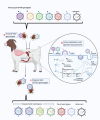Severe fever with thrombocytopenia syndrome virus: emerging novel phlebovirus and their control strategy
- PMID: 33953322
- PMCID: PMC8178303
- DOI: 10.1038/s12276-021-00610-1
Severe fever with thrombocytopenia syndrome virus: emerging novel phlebovirus and their control strategy
Abstract
An emerging infectious disease first identified in central China in 2009, severe fever with thrombocytopenia syndrome (SFTS) was found to be caused by a novel phlebovirus. Since SFTSV was first identified, epidemics have occurred in several East Asian countries. With the escalating incidence of SFTS and the rapid, worldwide spread of SFTSV vector, it is clear this virus has pandemic potential and presents an impending global public health threat. In this review, we concisely summarize the latest findings regarding SFTSV, including vector and virus transmission, genotype diversity and epidemiology, probable pathogenic mechanism, and clinical presentation of human SFTS. Ticks most likely transmit SFTSV to animals including humans; however, human-to-human transmission has been reported. The majority of arbovirus transmission cycle includes vertebrate hosts, and potential reservoirs include a variety of both domestic and wild animals. Reports of the seroprevalence of SFTSV in both wild and domestic animals raises the probability that domestic animals act as amplifying hosts for the virus. Major clinical manifestation of human SFTS infection is high fever, thrombocytopenia, leukocytopenia, gastrointestinal symptoms, and a high case-fatality rate. Several animal models were developed to further understand the pathogenesis of the virus and aid in the discovery of therapeutics and preventive measures.
Conflict of interest statement
The authors declare no competing interests.
Figures


References
-
- ICTV. ICTV Taxonomy History: SFTS virus, https://talk.ictvonline.org/taxonomy/p/taxonomy-history?taxnode_id=20141... (ICTV, 2020).
-
- Wiwanitkit S, Wiwanitkit V. Acute viral hemorrhage disease: a summary on new viruses. J. Acute Dis. 2015;4:277–279.
-
- Jo Y-S, et al. Prevalence of severe fever with thrombocytopenia syndrome virus in ticks collected from national parks in Korea. Vector-Borne Zoonotic Dis. 2019;19:284–289. - PubMed
Publication types
MeSH terms
LinkOut - more resources
Full Text Sources
Other Literature Sources

